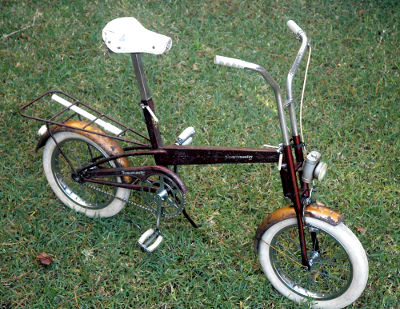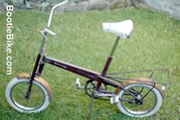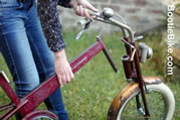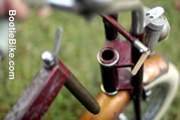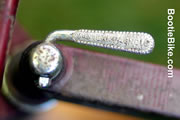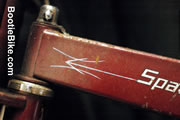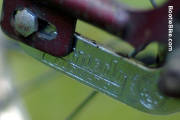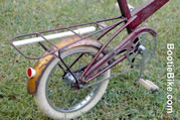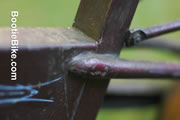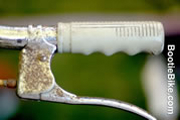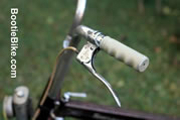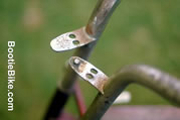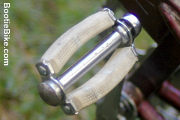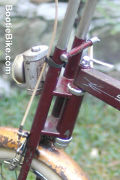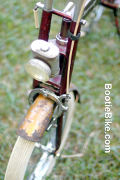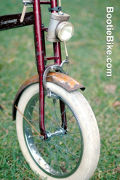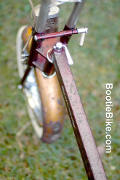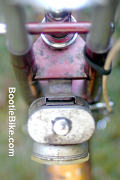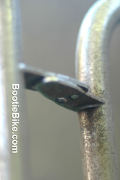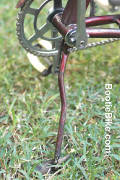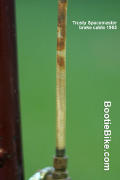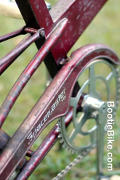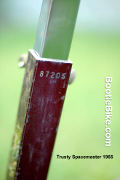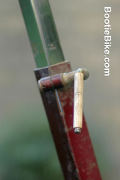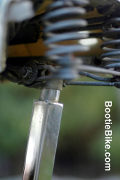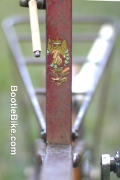First generation Trusty Spacemaster 1965
A small manufacturer's answer to the Moulton Stowaway
Meet the Spacemaster, a small-wheeled bike that separated into two pieces for easy transport and storage. 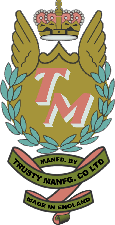 It was Trusty Manufacturing's take on the Moulton Stowaway, the original small-wheeled separable.
It was Trusty Manufacturing's take on the Moulton Stowaway, the original small-wheeled separable.
Trusty was a maker of children's pavement cycles based at the Angel Factory Colony, Edmonton, North London. It was established in 1959 by the principals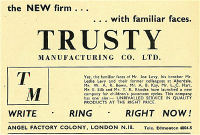 of the defunct Aberdale Cycle Co Ltd, which made autocycles and small motorcycles at a factory (demolished in 2015) in nearby Bridport Road. (Thanks to Iceni CAM Magazine / Mark Daniels)
of the defunct Aberdale Cycle Co Ltd, which made autocycles and small motorcycles at a factory (demolished in 2015) in nearby Bridport Road. (Thanks to Iceni CAM Magazine / Mark Daniels)
The products of the new firm were somewhat unconventional, with unique frames and a look all their own. One distinctive feature was motorcycle-style triple clamps – triangular plates, upper and lower, locating the forks – which was perhaps a reflection of their experience with motorised two wheelers. And they didn't change their ways when it came time to produce a bike for adults; it was just more of the same, only bigger.
A unique design
The Spacemaster may separate like the Moulton Stowaway, but the way it does so is entirely different. There is no split midway along the frame (à la Moulton), or the weakness that goes with it. Instead the fork/handlebar assembly separates from the rest of the bike. The two chunks, the fork/handlebar assembly and the rest, are held together by a cylindrical extension on the front of the frame that fits snugly into a 'hole' in the fork/handlebar assembly, and is secured there by a Campagnolo quick release. The hole is actually the void within the inner races of the headset bearings. On a conventional bike, the steerer occupies that space, while the races themselves are located in the frame (i.e. the steer tube), the opposite of the arrangement on the Trusty.
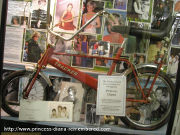
Each fork blade extends upwards way above the forks themselves, and each has an open top. Each of the handlebars – yes, there are two separate handlebars – fits into one of those open tops. The bars can be swivelled out of the way to save storage space (and they can be removed altogether, albeit with the brake cable still attached to one).  In the riding position a notched tab on each handlebar interlocks with the other, and they are secured in that position by an (extra long) seat post bolt that clamps them within their fork tubes. (That bit's important; I got a terrible fright when I rode it without that clamp tight enough.)
In the riding position a notched tab on each handlebar interlocks with the other, and they are secured in that position by an (extra long) seat post bolt that clamps them within their fork tubes. (That bit's important; I got a terrible fright when I rode it without that clamp tight enough.)
The square section seat tube, with the bottom bracket shell on its lower extremity, neatly abuts the rear of the rectangular-section main beam. The seat stays kink their way across a low arc from the dropouts to the join of the main member and seat tube. The chain stays are short but otherwise boringly conventional. The seat post, being square to match the seat tube, is topped by a short section of round tube to accommodate a conventional saddle clamp. The seat post is heavily chromed and quite presentable, as befits a world first. Even Dr Moulton didn't think so far outside the square (ahem).
Being a separable, it would have been impracticable to have cables going to the rear, so a (cable-controlled) three speed hub and/or rear brake would not have been suitable. Rather than content themselves with a single speed and coaster brake, the Trusty people did the smart thing and opted for the German two speed Fichtel & Sachs Duomatic hub. This offers a much-needed second gear as well as a coaster brake, 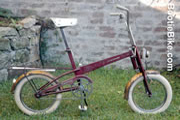 without the need for any cables. It suits the bike to a tee, and as a bonus there's nothing to go wrong, minimal maintenance is needed and there is no cable ugliness. I like to kid myself that the Trusty people, sensitive to the panzerwerks aesthetic of their new baby, chose the duomatic because they couldn't bear to have messy cables spoiling the looks!
without the need for any cables. It suits the bike to a tee, and as a bonus there's nothing to go wrong, minimal maintenance is needed and there is no cable ugliness. I like to kid myself that the Trusty people, sensitive to the panzerwerks aesthetic of their new baby, chose the duomatic because they couldn't bear to have messy cables spoiling the looks!
On the road
This particular Spacemaster, somewhat less than pristine, looks like another rescue, perhaps straight out of a skip bin – and it's good to see it saved. Fully rebuilt (no expense spared!), the only non-original parts are the bottom bracket  spindle, bearings and fixed cup, and the front brake cable. It was a blow to lose the rusted original cable, as it had a braided outer sheath which I think would be quite unusual, like the whole bike for that matter.
spindle, bearings and fixed cup, and the front brake cable. It was a blow to lose the rusted original cable, as it had a braided outer sheath which I think would be quite unusual, like the whole bike for that matter.
As for riding, the Trusty is pleasant enough, but it’s a fairly small bike, and I’m sometimes conscious of that when I feel as though I’m ‘perched’ on it (and I’m only 170cm). It has the same 305 ETRTO wheels and fat tyres as the Raleigh RSW and CWS Commuter, and as with those bikes I’m initially aware of the high rolling resistance but soon forget about it. There's nothing particularly notable about the steering, once you get used to the fact that one handgrip is noticeably higher than the other (did you really expect it to be that normal?).  Occasionally a resonant hum, emanating from the hollows of the rectangular-section frame, accompanies my ride; a friendly reminder, if I needed one, that this ain’t no ordinary bike.
Occasionally a resonant hum, emanating from the hollows of the rectangular-section frame, accompanies my ride; a friendly reminder, if I needed one, that this ain’t no ordinary bike.
Having only two speeds, the Spacemaster can be a bit of a workout compared to a three speed in hilly terrain, but it generally suits this bike's purpose in life. Further, the convenience of the kick-back gearchange 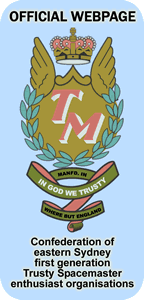 is very easy to get used to, and one could forgive it all sorts of sins for that. And besides, the thing puts a smile on my face. The front caliper brake, the typical steel single pivot type of the time, but with a long reach to clear the fat tyres, is only marginal, but the coaster at the rear is good enough to be reassuring. Overall, it’s fine for its intended purpose.
is very easy to get used to, and one could forgive it all sorts of sins for that. And besides, the thing puts a smile on my face. The front caliper brake, the typical steel single pivot type of the time, but with a long reach to clear the fat tyres, is only marginal, but the coaster at the rear is good enough to be reassuring. Overall, it’s fine for its intended purpose.
Later Spacemasters and Spacemaster copies
This model Trusty Spacemaster, the first generation, was only around for a year or two. Subsequent models became progressively more 'normal'.
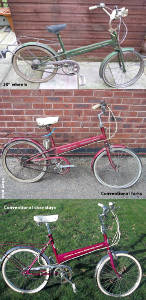
Over time they gained 20" wheels, conventional forks and conventional seat stays. However, they did maintain a version of the signature tapered, rectangular section main member, to the end (in the mid-70s?). The later Spacemasters were available in both 'fixed' and folding (not separable) versions (with a knob on top to release the hinge) and sold under the 'Delta' and then 'Viscount' names.
The existence of a couple of Spacemaster lookalikes suggests others appreciated the merits of the original Trusty design. The first of these is one I found on my internet travels. Unmistakable, but badged as a 'Tempest' (Dutch?), it has so much in common with the real thing that it may well be a licence-built version (that's a 70s Chinese '5 Rams' extendable behind it). The Tempest looks like a single speed, second generation Spacemaster, but with smaller wheels. It also has a stirrup (rod) front brake, which Spacemasters never had.
The other lookalike, badged as a 'Columbia', is believed to be a Dutch Sparta. It has the separating mechanism and the separate handlebars of the first generation Spacemaster, but bigger wheels. (Thanks to the Folding Society)
I hope you've enjoyed this little treatise on Trusty's contribution to the world of separable bikes. However, I cannot close without giving due mention to the one and only celebrity Trusty. Yes, the maker of the Spacemaster did have its 15 minutes of fame, but it had to wait until May 2007, when the late Princess Diana's childhood bike went under the hammer. The red Trusty 'Tracker', a Raleigh Chopper-style bike, sold for £1200. It now lives in the House On The Hill Toy Museum in Stansted, Essex. If only the little Trusty firm had had some idea, in those far off days, that they enjoyed such royal patronage…


